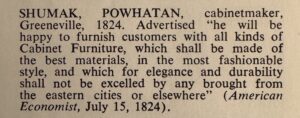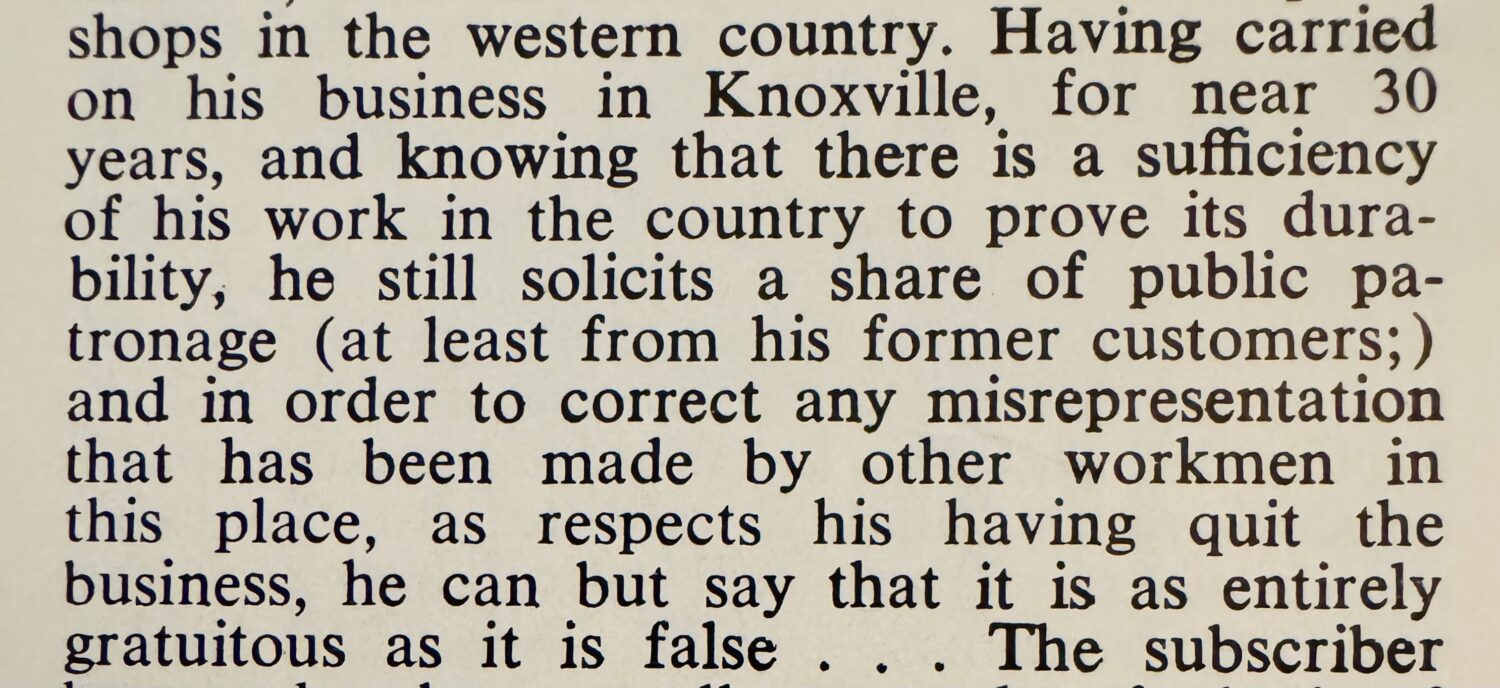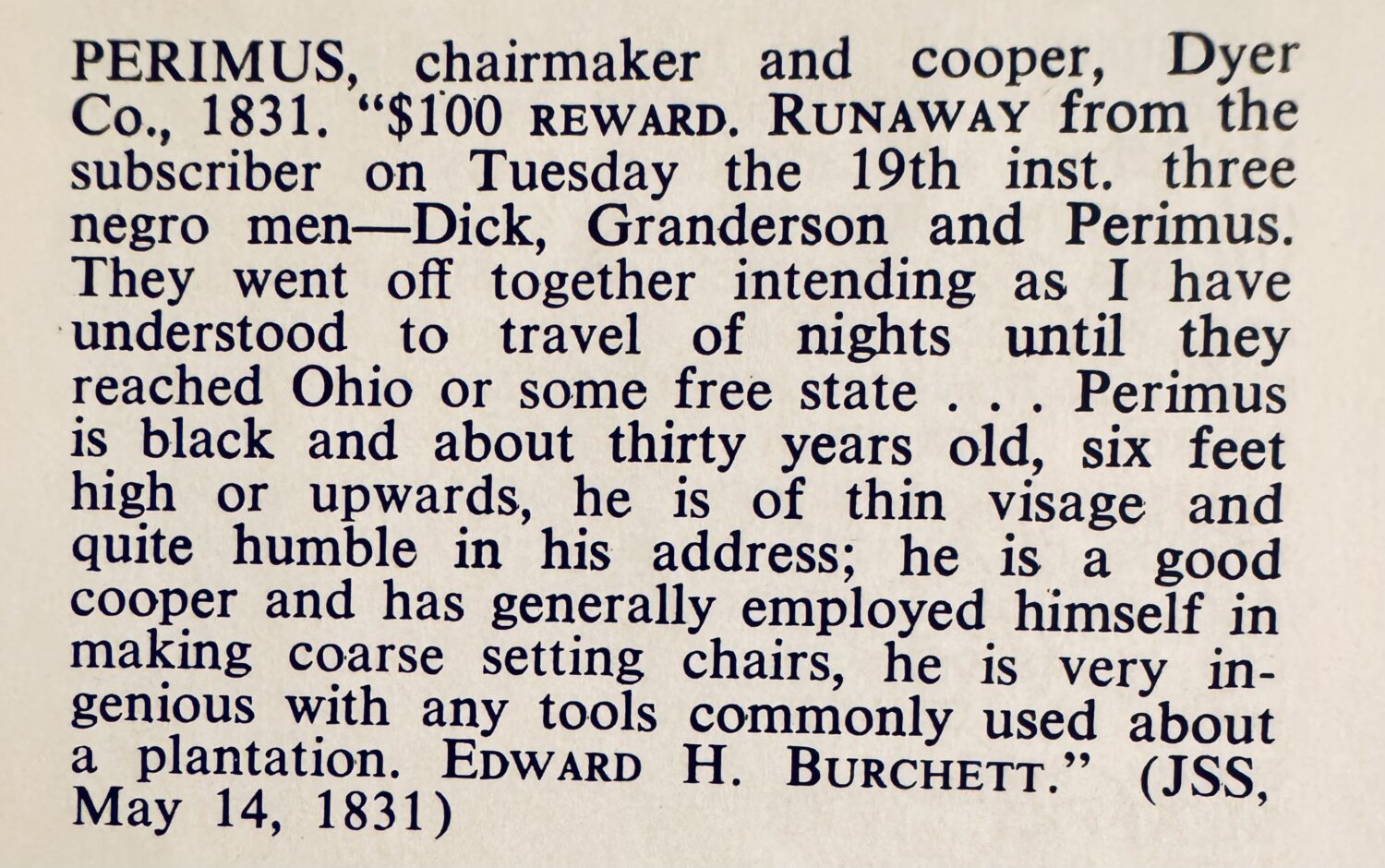

Effectively earlier than gaining statehood in 1796, carpenters, cabinetmakers and chairmakers had been leaving Jap Seaboard states to settle in Tennessee. They crossed the mountains utilizing The Nice Street (often known as The Nice Wagon Street). They marketed their providers in native newspapers and, very fortuitously for me, and presumably for you, these advertisements had been collected by Ellen Beasley, a researcher for the Historic Websites Federation of Tennessee. Her sources had been newspapers and the 1820 Census of Producers.
Following is a number of ads and census data relationship from 1809 to 1840 taken from Ellen Beasley’s article, “Tennessee Cabinetmakers and Chairmakers By means of 1840,” revealed in Antiques Journal, October 1971. On the finish of the advertisements you will note capital letters that are keys to the newspaper or census supply.
John D. Goss on the Worth of Mechanical Labor and a Hearse Out there
In 1824 John Goss traveled by horseback from Baltimore to Nashville. The earliest advert for his cabinetmaking enterprise is from 1830 (see the highest determine). Goss’ ads are a superb instance of the “cradle to grave” providers carpenters and cabinetmakers supplied to the general public. The final line within the illustration at high is, “N.B. He has additionally ready himself to make with nice dispatch the final article to which his fellow-men requires on this facet of eternity.”

His 1831 advert included a promise to cost Cincinnati costs and in N.B. “A hearse shall be saved in rediness always.”
In an advert from 1837 the end-of-life service is once more famous.

Jap Types Made Right here
A cabinetmaker’s advert usually identified their capacity to make furnishings within the kinds of the massive Jap cities. They had been up towards furnishings sellers importing and promoting furnishings from New York, Philadelphia, Baltimore and ultimately Cincinnati.

You Made How A lot ?
The place potential, Ellen Beasley matched a craftman’s advert to productiveness data from the 1820 Census of Producers. James S. Bridges was a chairmaker in Knoxville. An advert from August 1819 advises the general public he has opened for enterprise. On the finish of his advert is an inventory of the outlets’ productiveness as discovered within the census (“Do” means ditto) and the census taker’s alternate spelling for chairs.
Within the case of James Bridges we be taught the kinds of chairs made in his store.

Cabinetmaker John Ashton was situated in Hawkins County within the northeast nook of the state. With out this bit of knowledge from the 1820 Census we’d not know of him.

Tremendous & Tasty Language
Many advertisements have related language, doubtless the phrases used had been copy steered by the newspaper. Mr. N. Bell, cabinetmaker of Lebanon, appears to have written his personal copy and boldly claims you don’t should go to the massive metropolis for effective tasty furnishings.

A Bedstead Patentee
Many patents had been issued that addressed the soundness and luxury of bedsteads. Henry Boyd labored on bettering the fastening of the rails to the vertical posts. A Thomas Early patent handled attaching mattress curtains (one a part of the entire vary of mattress garments), a necessity in poorly heated bedrooms.


A Feud Between Chairmakers & a Forger Reported
When enterprise slowed down it was a good suggestion to remind the general public that you simply had been nonetheless in enterprise and the place you would be discovered. In October 1810, Charle M’Karahan let everybody know he was nonetheless making chairs, and he could possibly be discovered on the easy-to-remember location reverse the brand new jail.

John Priest arrange his chairmaking enterprise a pair years earlier than M’Karahan. Right here is his 1809 woodblock-print advert saying his enterprise. Nancy Goyne Evans included this picture in her publications on Windsor chairs.

It appears inside a yr of M’Karahan settling in he had a disagreement with Priest over cash. The feud was settled in courtroom in December 1811 and Priest, with a lot obvious gloating, paid for an advert to let the general public know.

A few yr later Priest gave up chairmaking in Nashville and resorted to cabinetmaking.
M’Karahan continued to work in Nashville and issued a public service announcement in early 1813 warning that one other chairmaker was a forger.

Malicious Mischief & Homicide by Cabinetmakers
Chairmakers shall be relieved to know they, to date, weren’t the worst within the furnishings world, no less than in Tennessee, and earlier than the yr 1840.

Malicious mischief is the willful destruction of property, both public or owned by one other particular person. Phineas, together with his rascally countenance and obvious lack of contrition, had no intention of staying behind bars and broke jail. I hope they caught him.

A nasty piece of labor, is (was) this Kinchen Wilborn. When apprehended, he was properly into Arkansas Territory (statehood was in 1836) and traveled nearly 250 miles. The slippery scoundrel escaped and we don’t know if he was ever caught.
Marriage & Misdirection
Let’s throw in a turner for some comedian reduction. Ferdinand Rienman, a turner in Nashville, introduced his marriage ceremony to Miss Susannah Rule by way of poetry. Intelligent.

Ulysses G. Smith, printer and cabinetmaker, took a special strategy to marriage. He married Miss Rosannah Mc’Affy on February 1, 1827, with the newspaper announcement on February 7. One week later he ran an advert saying he had taken over the institution previously occupied by his father-in-law, Terrence Mc’Affry, additionally a cabinetmaker.

Mc’Affry was well-known and revered in Knoxville. He had been in enterprise as a cabinetmaker for about 27 years. Smith’s announcement took him unawares. He quickly responded to Ulysses Smith’s declare in one other advert.

Wait, there’s extra! Mc’Affry, aged “upwards of 60 years” died in April 1830, with the report of his funeral within the April 14 version of the Knoxville Register. Per week earlier, in the identical newspaper, it was reported Mc’Affry’s daughter sued Ulysses Smith for divorce. Oh, poor Ulysses, Rosannah selected to not be your Penelope.
Kudos to Ellen Beasley for matching up the juicy particulars of this cabinetmaker cleaning soap opera.
Cherry & Walnut Needed
A great way to search out out what woods had been utilized by cabinetmakers and chairmakers in a specific space is to search out this kind of advert.

Runaway
Commercials for runaway apprentices and enslaved servants had been widespread. This advert, for an enslaved craftsman and two others, is notable for the massive reward and the outline of Perimus. He was clearly expert and well-regarded by Burchett.

However, after an escape the standard plan of action was to query and punish different enslaved in an effort to discover out the place the runaways had been headed. Dyer County is within the far western a part of Tennessee, north of Memphis. The runaways had a protracted and dangerous journey to achieve freedom.
On the Signal of the Giant Chair

I’ve a specific fondness for indicators depicting the article made and on the market inside a store. Large footwear, huge lock and keys, huge fish and so forth. Did Isaac Barton have a chair painted on an indication or an precise massive chair suspended from an iron assist? Additionally, precisely how huge was this huge chair?
I’m Nonetheless Right here

On the finish of the yr, a weary “I’m nonetheless right here” is a sentiment many people would possibly really feel, whereas others would possibly lean in direction of shocked consternation. As for Mr. William Younger, contemplating Shelbyville was not a one-horse city, together with your location in your commercial would have been a good suggestion.
N.B. Ellen Beasley’s work in digging up the ads for cabinetmakers and chairmakers earlier than 1840 was a gargantuan process. It required many hours of journey all through Tennessee to look by way of bodily editions of newspapers, newspapers on microfilm and microfiche and deciphering the handwriting of the 1820 census takers. After working in Tennessee she continued her analysis work in Texas and in 1984 was named a Loeb Fellow at Harvard’s Graduate College of Design.
– Suzanne Ellison
Right now marks the winter solstice, the shortest day of the yr and the longest night time. Final yr I wrote a brief story, “The Lengthy Night time” for this weblog. If you want to learn, or reread, the story you could find it right here.

